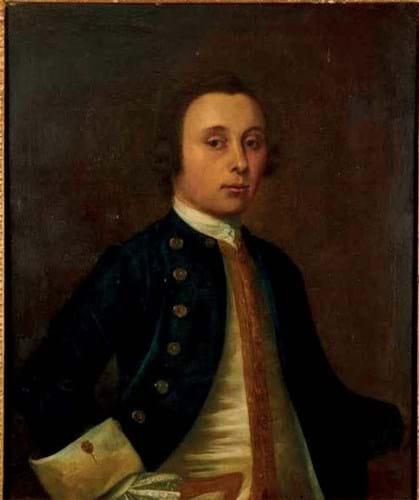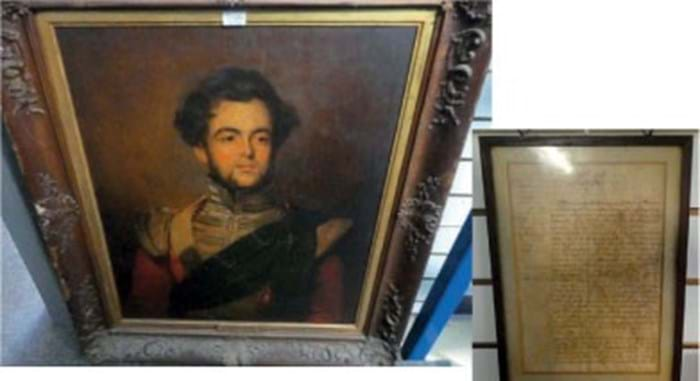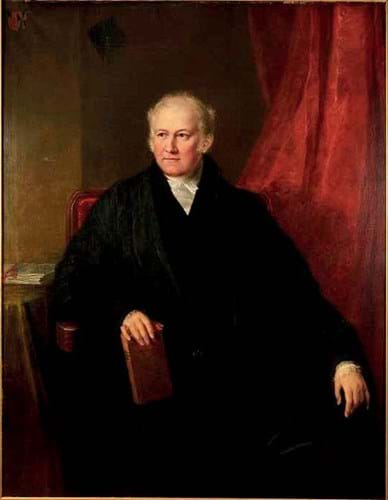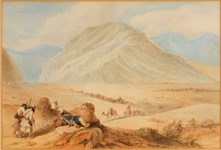
Portrait of Lt Charles Le Hardy RN, catalogued as ‘English School, c.1740’ that sold for £11,000 at Reeman Dansie.
A couple of lots at the latest Fine Art & Antiques sale at Reeman Dansie (22.5% buyer’s premium) showed the difference the latter can make.
The sale in Colchester on February 14 offered a portrait of Lt Charles Le Hardy (1716-1780) which was catalogued as ‘English School, c.1740’. It came to auction from a local vendor whose family descended from the sitter.
Although in slightly tired condition, having been re-lined some decades ago and with some areas of overpainting visible under a UV light, the auction house described it as “an impressive looking portrait”.
Known as Charles Hardy, the sitter was born in Portsmouth into a well-known Jersey family with a strong naval tradition.
He entered the Royal Navy aged 16 and was made lieutenant in 1737 and captain in 1741. In 1755 he was knighted and appointed Governor of New York, serving during a period of heightened tensions and rebellion in the colony.
In 1757 he was promoted to Rear Admiral of the Blue and later he was made Governor of Greenwich Hospital. After a spell as MP for Portsmouth from 1774, he returned to the navy and in 1779 was made Commander-in-Chief of the Channel Fleet. He died a year later.
The 2ft 6in x 2ft 1in (77 x 63cm) oil on canvas, which came in a period carved gilt frame, showed Hardy in his 20s wearing a silk waistcoat and blue coat. It was painted at a time when he was climbing up the naval ranks.
Reeman Dansie director and auctioneer Jonathan Benson said: “The artist was unknown but the portrait was certainly good quality. It was the sitter, though, that really appealed here together with the ‘come and buy me’ estimate.”
Pitched at £2500-3500, it drew bidding from a number of parties including a UK naval institution but was eventually knocked down to the trade at £11,000. It will be interesting to see if a named artist can now be established.
Third time lucky
Also at the sale, a portrait of another MP drew attention despite having sold at auction elsewhere twice recently.
The portrait of James Scarlett by William Derby (1786-1847), a 4ft 8in x 3ft 8in (1.42 x 1.13m) oil on canvas signed and dated 1826, was believed to be one of the artist’s Royal Academy exhibits.
It had sold at Bonhams last September for £750, then £420 at Willingham Auctions in Cambridge barely two months later. However, the sitter was better known in the east of England – he served as the MP for Norwich and died in Bury St Edmunds, Suffolk, aged 74. It therefore performed markedly better in Colchester.
A lawyer and judge, as well as a politician, Scarlett had served as Attorney General but his opposition to the Reform Bill meant he left the Whigs and joined the Tories in the early 1830s. A lithograph of the sitter can be found in the National Galleries of Scotland which differs slightly in composition and may be after another version of this painting.
Here the portrait was estimated at £1000-1500 and, after some good interest and commission bids emerged, it sold for £3200 to a London buyer. According to Artprice, the sum represents the highest at auction for an individual painting by Derby.
High and low

Portrait of Captain RHJ Beaumont of the 92nd Highlanders, which sold together with an earlier letter for £15,500 at Pump House Auctions.
Meanwhile an unsigned but intriguing oil painting of a military figure drew significant competition against a lowly estimate at Pump House Auctions (20% buyer’s premium) in Swanmore, Hampshire, on March 4.
A plaque to the frame stated that the sitter was Captain RHJ Beaumont of the 92nd Highlanders.
Measuring 2ft x 2ft 5in (62 x 74cm), it came with an intriguing framed letter from ‘William Blathwayt (or Blathwayte)’ instructing a Richard Beaumont to raise a company of 60 private soldiers for the regiment under Colonel George Viscount Castleton.
However, the letter was dated March 16, 1689, which did not seem to correspond to the date of the painting.
The 92nd (Gordon) Highlanders regiment was not founded until 1792 while the sitter’s uniform looked more like those from the early 19th century.
It was therefore possible that the letter referred to an earlier Richard Beaumont who first founded an embryonic unit before it officially became the 92nd Highlanders, and the RHJ Beaumont in the portrait perhaps was a descendant who served in it.
The writer of the letter was certainly a notable figure, however. William Blathwayte (1649-1717) was an English diplomat, public official and Whig politician who sat in the House of Commons between 1685 and 1710. He established the War Office as a department of the British Government and played an important part in administering the English (later British) colonies of North America.
The fact that it dated from 1689 implied the letter related to the mustering of troops to counter the Jacobite rebellion in Scotland under ‘Bonnie Dundee’.
So the lot was something of a dual offering: a well-painted portrait plus a manuscript of historical and military interest relating to the immediate aftermath of the Glorious Revolution.
While it is difficult to determine which item bidders were keener to acquire, either way the £200-300 estimate was easily surpassed.
The lot was eventually knocked down at £15,500.















